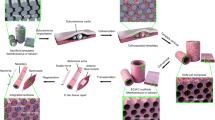Abstract
We have proposed engineering tissues by the incorporation and sustained release of plasmids encoding tissue-inductive proteins from polymer matrices. Matrices of poly(lactide-co-glycolide) (PLG) were loaded with plasmid, which was subsequently released over a period ranging from days to a month in vitro. Sustained delivery of plasmid DNA from matrices led to the transfection of large numbers of cells. Furthermore, in vivo delivery of a plasmid encoding platelet-derived growth factor enhanced matrix deposition and blood vessel formation in the developing tissue. This contrasts with direct injection of the plasmid, which did not significantly affect tissue formation. This method of DNA delivery may find utility in tissue engineering and gene therapy applications.
This is a preview of subscription content, access via your institution
Access options
Subscribe to this journal
Receive 12 print issues and online access
$209.00 per year
only $17.42 per issue
Buy this article
- Purchase on Springer Link
- Instant access to full article PDF
Prices may be subject to local taxes which are calculated during checkout




Similar content being viewed by others
References
Langer, R. & Vacanti, J.P. Tissue engineering. Science 260, 920–926 ( 1993).
Kim, B.S. & Mooney, D.J. Development of biocompatible synthetic extracellular matrices for tissue engineering. Trends Biotechnol. 16, 224–230 ( 1998).
Mooney, D.J. et al. Long-term engraftment of hepatocytes transplanted on biodegradable polymer sponges. J. Biomed. Mater. Res. 37, 413–420 (1997).
Deuel, T.F. in: Principles of tissue engineering (eds Lanza, R.P., Langer, R. & Chick W.L.) 133–150 (Academic, San Diego, 1997).
Langer, R. New methods of drug delivery. Science 249, 1527–1533 (1992).
Jong, Y.S. et al. Controlled release of plasmid DNA. J. Cont. Rel. 47 , 123–134 (1997) [Not In Index Medicus Please Spell Out].
Labhasetwar, V., Bonadio, J., Goldstein, S., Chen, W. & Levy, R.J. A DNA controlled-release coating for gene transfer: transfection in skeletal and cardiac muscle. J. Pharm. Sci. 87, 1347–1350 (1998).
Ledley, F.D. Pharmaceutical approach to somatic gene therapy. Pharm. Res. 13, 1595–1614 (1996).
Giannobile, W.V. Periodontal tissue engineering by growth factors. Bone 19, 23S–37S (1996).
Harris, L.D., Kim, B.S. & Mooney, D.J. Open pore biodegradable matrices formed with gas foaming. J. Biomed. Mat. Res. 42, 396– 402 (1998).
Wong, W.H. & Mooney D.J. in Synthetic biodegradable polymer scaffolds (eds Atala, A. & Mooney, D.J.) 51– 82 (Birkhausen, Boston; 1997).
Raines, E.W. & Ross, R. in Biology of platelet-derived growth factor (eds Westermark, B. & Sorg, C.) 74– 114 (Karger, Switzerland; 1993).
Peters, M.C. & Mooney, D.J. in Tissue engineering for therapeutic use 2. (eds Ikada, Y. & Enomoto, S.) 55–65 (Elsevier, Amsterdam; 1998).
Langer, R. Drug delivery and targeting. Nature 392S, 5–10 (1998).
Hedley, M.L. Curley, J. & Urban, R. Microspheres containing plasmid-encoded antigens elicit cytotoxic T-cell responses. Nat. Med. 4, 365–368 (1998).
Nor, J.E., Christensen, J., Mooney, D.J. & Polverini, P. VEGF enhances the survival of endothelial cells and sustains angiogenesis by inducing expression of Bcl-2. Am. J. Pathol. 154 , 375–384 (1999).
Stein, G.S., Lian, J.B., Stein, J.L., Van Wijnen, A.J. & Montecino, M. Transcriptional control of osteoblast growth and differentiation. Physiol. Rev. 76, 593– 629 (1996).
Fang, J. et al. Stimulation of new bone formation by direct transfer of osteogenic plasmid genes. Proc. Nat. Acad. Sci.USA 93, 5753–5758 (1996).
Acknowledgements
The authors gratefully acknowledge technical assistance from Jeremy Blum and Elly Liao. Financial support for this work was provided by National Institutes of Health grant 1RO1DE13004, Reprogenesis, and Selective Genetics. L.D.S. was supported by National Institute of Dental Researchtraining grant DE07057.
Author information
Authors and Affiliations
Corresponding author
Rights and permissions
About this article
Cite this article
Shea, L., Smiley, E., Bonadio, J. et al. DNA delivery from polymer matrices for tissue engineering. Nat Biotechnol 17, 551–554 (1999). https://doi.org/10.1038/9853
Received:
Accepted:
Issue Date:
DOI: https://doi.org/10.1038/9853
This article is cited by
-
Stimuli-responsive DNA-based hydrogels for biosensing applications
Journal of Nanobiotechnology (2022)
-
Programmable multi-DNA release from multilayered polyelectrolytes using gigahertz nano-electromechanical resonator
Journal of Nanobiotechnology (2019)
-
MicroRNAs delivery into human cells grown on 3D-printed PLA scaffolds coated with a novel fluorescent PAMAM dendrimer for biomedical applications
Scientific Reports (2018)
-
Scaffold-mediated delivery for non-viral mRNA vaccines
Gene Therapy (2018)
-
Gene-activated matrix/bone marrow-derived mesenchymal stem cells constructs regenerate sweat glands-like structure in vivo
Scientific Reports (2017)



